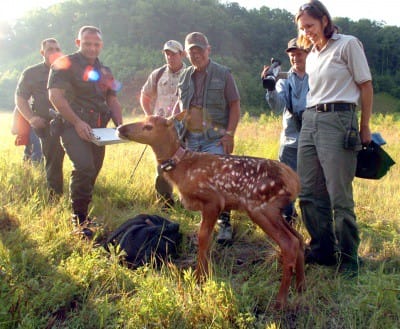
If things go as planned, Virginia will become the latest state east of the Mississippi River to have a free-ranging elk herd. At least six other states have free-ranging elk, which were native to much of the East until they were extirpated in the mid-1800s.
Actually, Virginia already has elk thanks to the Kentucky Department of Fish and Wildlife Resources and the Rocky Mountain Elk Foundation, which partnered on an aggressive reintroduction program in 1997 when seven elk were released in eastern Kentucky. Since then, 1,500 more were transplanted from seven different states and the herd has grown to an estimated 10,000 animals. It’s an unparalleled success story.
It’s also turned into an incredibly popular hunting program. Last year alone, 46,000 people paid a $10 application fee to the KDFWR last year for the chance to buy one of 750 cow or 250 bull tags. The number of elk licenses awarded this year will decrease to 800, a move that reflects the Department’s desire to increase the overall quality of the hunt, says RMEF regional director Bill Carman. Last year, a hunter killed a non-typical 6×6 bull that scored 372 6/8 Boone & Crockett points, and the state-record typical bull was taken in 2007. It scored 371. Can things actually get any better?
“I have no doubts,” says Carman.
Kentucky’s booming herd is a result of several factors. First, there are few major predators. Elk calves have a 92 percent survival rate. Disease rates are low, the weather is mild and above all, says Carman, the habitat is ideal. The reclaimed surface coal mines throughout eastern Kentucky are covered with grasses and other lush growth, providing an ample supply of food all year.

That’s why herds are expected to thrive in other coal mining states like Virginia and West Virginia, which also has spill-over elk from Kentucky but no management plan yet. North Carolina also has a small elk herd, but like West Virginia, it doesn’t yet allow hunting. Three other states east of the Mississippi River do have limited hunting seasons. Pennsylvania hunters killed 40 elk during the 2008 season and 337 since the state held its first hunt in modern history in 2001. Five elk were taken by all five hunters awarded tags in Tennessee last fall, and Michigan also has an elk hunting program.
It makes perfect sense for Virginia to be next. The bulk of Kentucky’s herd lies in a 16-county region, including four that border southwest Virginia’s mountainous coal fields. The habitat is similar, and elk that have been crossing into Virginia over the last decade have been thriving. That is, if they weren’t been shot by Virginia hunters. Fearing the spread of chronic wasting disease, the Virginia Department of Game and Inland Fisheries actually declared open season on elk and made them legal game in regions bordering Kentucky. Fortunately, the state changed its stance and is moving toward an active management plan that will likely include regulated hunts in the distant future.
Representatives of the RMEF are thrilled about the idea, but not everyone in Virginia wants elk. Supervisors from two of three Virginia counties targeted for reintroduction have expressed opposition to the idea. They are concerned about crop damage and competition with cattle. Carman, however, says that hasn’t been a problem in Kentucky.

Even if elk do create some headaches for farmers, the losses will likely be offset by the revenue generated by tourists and hunters. Kentucky hunters spend an average of $1,000 each on gear, lodging, meals and other expenses related to their hunt. Elk have also proven an economic windfall for Pennsylvania, which has 600 to 700 animals in a small area of north-central Pennsylvania. One study suggested the elk will generate an estimated $18.6 million by 2012, mostly from tourists who visit the region to view the animals.



